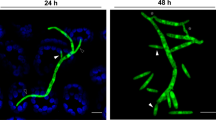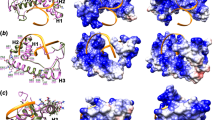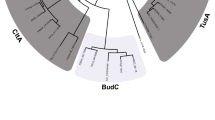Abstract
Histoplasma capsulatum, like many other fungal pathogens, is dimorphic: it exists as mycelia in the soil and yeast in animal hosts. Because only the yeast phase is parasitic, factors which affect morphogenesis have been of interest for understanding and controlling pathogenicity. In culture, the mycelial to yeast transition of H. capsulatum is induced by a temperature shift from 25 to 37 °C (ref. 1). The transition occurs over several days and is accompanied by marked changes in metabolic processes, including respiration and cysteine metabolism2. Here, we show that the triggering event for these morphological and biochemical changes is a rapid decline in intracellular ATP levels that follows uncoupling of oxidative phosphorylation when mycelia are shifted from 25 to 37 °C. We also show that respiration in the yeast phase is coupled at 37 °C and thus that the morphological transition may be viewed as a heat shock followed by cellular adaptation to higher temperature.
This is a preview of subscription content, access via your institution
Access options
Subscribe to this journal
Receive 51 print issues and online access
$199.00 per year
only $3.90 per issue
Buy this article
- Purchase on Springer Link
- Instant access to full article PDF
Prices may be subject to local taxes which are calculated during checkout
Similar content being viewed by others
References
Salvin, S. B. J. infect. Dis. 84, 275–283 (1949).
Maresca, B. et al. Proc. natn. Acad. Sci. U.S.A. 78, 4596–4600 (1981).
Lardy, H. A., Johnson, D. & McMurray, W. C. Archs Biochem. Biophys. 78, 587–597 (1958).
Slater, E. C. Meth. Enzym. 10, 48–57 (1967).
Sacco, M. et al. J. biol. Chem. (in the press).
Luzikov, V. N., Kubatov, A. S. & Rainina, E. I. Bioenergetics 5, 129–149 (1973).
Scherr, G. H. Expl Cell Res. 12, 92–107 (1957).
Ashburner, M. & Bonner, J. J. Cell 17, 241–254 (1979).
Schlessinger, M. J., Aliperti, G. & Kelby, P. M. Trends biochem. Sci. 7, 222–225 (1982).
Lowry, O. H. & Passonneau, J. V. A Flexible System of Enzymatic Analysis, 123–128 (Academic, New York, 1972).
Kornberg, A. Meth. Enzym. 497–500 (1975).
Author information
Authors and Affiliations
Rights and permissions
About this article
Cite this article
Lambowitz, A., Kobayashi, G., Painter, A. et al. Possible relationship of morphogenesis in pathogenic fungus, Histoplasma capsulatum, to heat shock response. Nature 303, 806–808 (1983). https://doi.org/10.1038/303806a0
Received:
Accepted:
Issue Date:
DOI: https://doi.org/10.1038/303806a0
This article is cited by
Comments
By submitting a comment you agree to abide by our Terms and Community Guidelines. If you find something abusive or that does not comply with our terms or guidelines please flag it as inappropriate.



